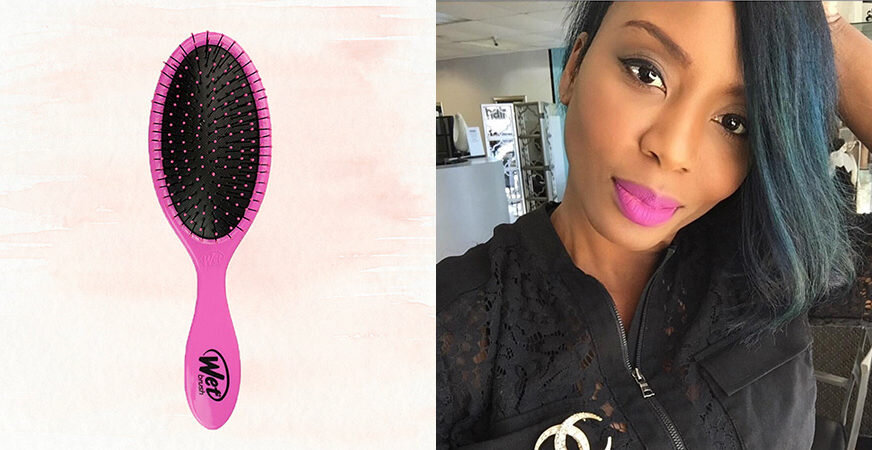4 Best Tools For Detangling Natural Hair
4 Best Tools For Detangling Natural Hair – Pekela Riley
Anyone who’ s had the incredible pleasure of raising boys, the way I’ve raised two myself, knows the incredible challenge of making them bathe when they’re young. After playing for hours in the sun, they would come back in the house and think they could just wash their face and “hit the spots.” I had to teach them that washing up, and spraying some cologne on will not cut it in my house. You got to hop your tail in the shower or tub!
It takes the same mindset and regimen to overcome the funk of detangling. Just like good hygiene, detangling is one of those things you must commit to for achieving a smooth and manageable set of hair. I’ve seen an unmanaged tangle knot, even on a Wet & Go, become so tight that it tangled into an unruly state where the person had to start considering growing a loc, forced by default to incorporate a style like “The Weeknd.”
Detangling is essential to the outcome of any style, and for properly managing the hair. Just like “hitting the spots” with a rag won’t cut it for bathing, you’re not just going to pick up anything and go right through some hair when detangling. However, there are some wonderful tools you can use for detangling natural hair from the root to the tip. Here’s my Top 4:
#1: CONDITIONERS & LEAVE-INS
At Salon PK we always condition and apply a leave-in before any instrument is used to detangle, to prime the hair and prepare it to be moved. Conditioners have a low PH, and lower PH builds the cuticles and good slippage. Also conditioners provide much needed hydration in addition to achieving elasticity for manageability. Conditioning is so important, because even if your hair is strong, if it’s dehydrated it will snap. Hydration creates flexibility and elasticity. Moisture in the hair give’s the ability to stretch without breaking.
For example, a child can fall down some steps and hop right back up in many cases without being too hurt, because the child’s body and bones are more flexible. However, let an older adult miss those same steps, and they could be in a full body cast from that fall.
#2: FRICTION FREE WET BRUSH
I feel like I’m giving away a trade secret with this one! I LOVE LOVE LOVE LOVE LOVE the Friction Free Wet Brush! I lose my mind if it’s not in my case.
A lot of naturals will come in the salon and panic because of detangling issues, but this Friction Free Wet Brush does the trick. Other brushes work ok if your hair is wet, but this brush is designed for wet hair. The spacing of the bristles are absolutely perfect – they’re not too close to pull the hair, but close enough to get smoothing. The bristles are friction free and have little balls that are mini detanglers on the end as well. They’re really gentle and smoothing, giving zero friction on the hair.
A rake comb and the Denman brush don’t even make my list. They became cool to say in the natural hair community – but in my opinion the Friction Free Wet Brush trumps them all. It’s also a white brush, so you have to keep it clean, which also helps you clearly see the amount of hair shedding. I don’t like dark brushes because you can’t see the amount of hair shedding. My shed test is my wet brush, which allows me to clearly see the shedding and be able to address certain issues with the client.
There’s not a head of hair I do from 1A-4C , relaxed to natural, that I don’t use my Friction Free Wet Brush. I LOVE IT!
#3: SECTIONING CLIPS
A very important part to detangling is sorting. Sometimes you have to repeat a section because it started to edge all randomly, and a clip will allow hair to stay after detangling. If you have big hair like a big fro or jumbo curls, you have to clip some of that off to organize a path to detangle. It’s just like a room that needs to be thoroughly cleaned. You have to section off the cleaning and attack in sections. Clips keep you on task and help organize the hair, which adds to a better detangling experience.
#4: SHEARS
If you run into an issue where you’re having “fairy knots” (meaning you don’t know where they’re coming from) or split ends, a great tool to pull out are the shears. With the shears you can do a light dusting, the most minimal of a trim, just to get rid of the little ends of the hair. Those split ends are like the bad apples in the bunch at school your parents told you not to hang around. The warning was “if you hang around them, you can become just like them.” Split ends are these bad apples. Some ends make more split ends, and go straight up the strands because you didn’t nip them in the bud from the jump. This makes the hair knot up, causing it to break.
Detangling Is For All
Depending on your hair type, detangling can be more challenging. On a scale of 1-10, course hair is a 20 in detangle challenge. But all hair of all textures, and the healthiest of hair, requires detangling. It will never end, you always have to detangle. Just like showering and bathing, detangling is a step you can’t skip. If you do, it will put your hair in a state of funk that will only compound and cost you in the end.
What’s been your worst detangling nightmare, and what tools did you use to tame it? Comment below with your detangling experiences and best practices.

